|
Recent Acquisitions
Just scroll down to see each painting
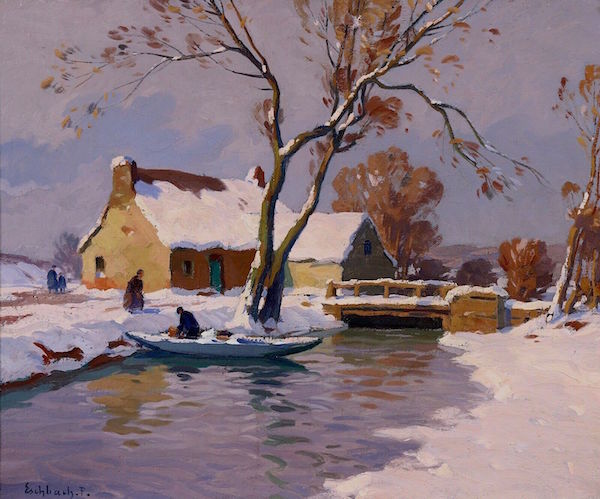
Paul André Eschbach, French (1881-1961)
Embarking in Winter
Oil on canvas 21 x 26, framed 30 x 35
$2000
Paul André Jean Eschbach was a pupil of Jean-Paul Laurens and Pharaon
Abdon Leon de Winter. He exhibited regularly in Paris at the Salon des
Artistes Français, of which he eventually became a member. In 1907, he
won a third-class medal and in 1920 a gold medal. He taught at the
Académie Julian from 1912 to 1938. His works can be found in several
provincial museums. After 1920, he tired of the interior and genre
scenes to which he had confined himself, started painting portraits and
made a reputation as a landscapist. He also painted seascapes and cloud
effects.
Edmond Petitjean, French, 1844-1925
Oil on canvas 24 x 30, in original frame 32 x 38
La rue St. Jacques a Parthenay $3500
French artist Edmund Petitjean was born in 1844 in Vosges and died
August 7, 1925, in Paris. Throughout his lifetime he painted views of
French rivers, towns, villages and ports on the Atlantic coast. He first
exhibited in Paris in 1874 at the Salon des Artistes Français, of which
he became a member in 1883. He was awarded an honourable mention in
1881, a first-class medal in 1884, a second-class in 1885, a silver at
the Paris Exposition Universelle of 1889, and a gold at the Exposition
Universelle of 1900. He was declared hors concours, and made a Chevalier
of the Légion d'Honneur in 1892. Today his work is represented in many
museums throughout France, including Le Musee D' Orsay in Paris.

SEARS GALLAGHER (1869-1955)
Fog Signal Bell, Monhegan
Watercolor 19 x 23 ; Framed 25 x 29
Provenance: Spanierman Gallery, New York.
$3500
Sears Gallagher was born in Boston in 1869. Gallagher studied in Boston with SPR Triscott in the 1880s as well as at the Académie Julian in Paris in 1895. Gallagher was a member of The Guild of Boston Artists, Chicago Society of Etchers, Society of Graphic Artists in New York City and American Federation of Arts. A prolific artist, Gallagher exhibited his works at the Boston Art Club (1887–1909), Paris Salon (1896), Pennsylvania Academy of the Fine Arts (1900–03, 1912 and 1916) and Art Institute of Chicago (1922). His works won various awards and were also exhibited at several well-known galleries throughout New England. Gallagher’s works can be found in the collections of the Museum of Fine Arts in Boston, Art Institute of Chicago, Library of Congress, Metropolitan Museum of Art, New York Public Library and Bibliothèque Nationale de France in Paris. As well as being a successful painter and etcher, Gallagher was a watercolor instructor at Boston University, Massachusetts. Gallagher was a member of the early group of artists who rediscovered and began painting on Monhegan Island, off the coast of Maine. He was introduced to the island by SPR Triscott, and beginning in 1898, he summered on the island every year for over 50 years, capturing the island’s beautiful and dramatic scenery.
(Biography provided by Wiscasset Bay Gallery)
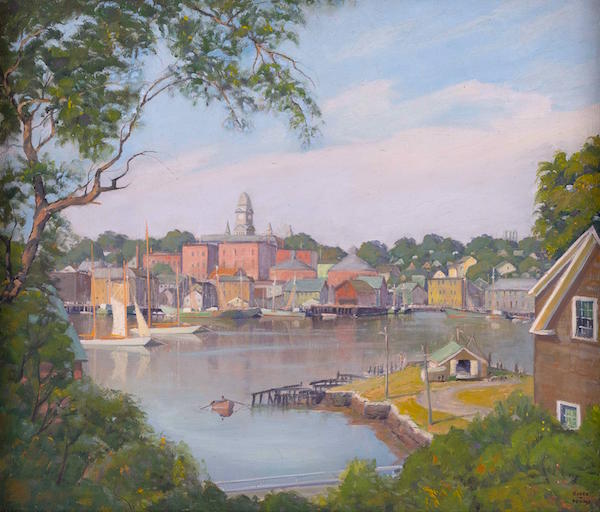
ROGER WILSON DENNIS (1902-1996)
East Gloucester, Plum Street
Oil on canvas, 20" x 24". Framed 28" x 32".
$2400
Roger Dennis carried the tradition of American Impressionism established by the Old Lyme Art Colony throughout the 20th Century until his death in 1996. In an interview in American Artist magazine (February, 1988), Dennis, a Norwich, CT native, recapped the major lesson of his apprenticeship: “If John Carlson and the other Old Lyme Impressionists taught me anything, it is that the center of interest is paramount. ‘Don’t try to put the world on a painting,’ Carlson would say. ‘Select one thing, put it down first, and subordinate all else to it, for there cannot be two pictures in one painting. ’ "
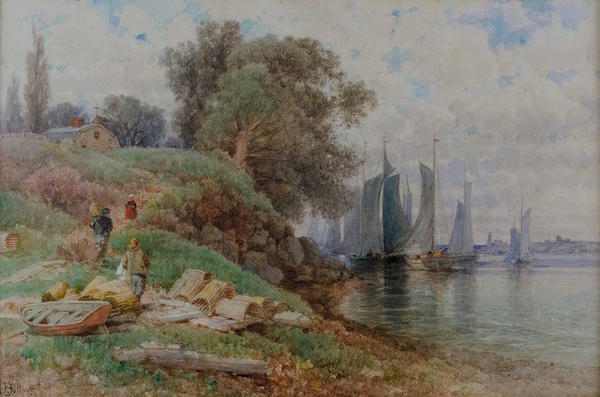
Albert Fitch Bellows (1829-1883)
Maine Coastal Scene, circa 1870
Watercolor, 23 x 15, Framed 27 x 34
$6000
Albert Fitch Bellows was an American landscape painter of the Hudson River School, born in Milford, Massachusetts. From 1850 to 1856 Bellows taught at the New England School of Design in Boston. Bellows resigned his post to travel and study abroad, and spent time in Paris and at the Royal Academy at Antwerp as well as in England. Bellows exhibited his first paintings at the National Academy of Design in 1857, becoming a full member in 1861.
Bellows spent most of his remaining career in New York, where he kept a studio in the same building as many of the notable Hudson River School artists of the time. His landscape oil paintings of the 1860s are fully in the late Hudson River School tradition, though Bellows depicted people more prominently in his landscape paintings than most other artists. Bellows excelled at figurative scene paintings. Bellows also differed from most Hudson River School artists in that he became skilled at watercolor, and was a founding member of the American Watercolor Society, and an honorary member of the Royal Belgian Society of Water-Colorists.
Bellows also mastered etching, along with Samuel Colman he was possibly the only other Hudson River School artist to do so and became a member of the New York Etching Club, the Philadelphia Society of Etchers and the Royal Society of Painter-Etchers and Engravers in London. Bellows died in Auburndale, Massachusetts, on the 24th of November 1883.
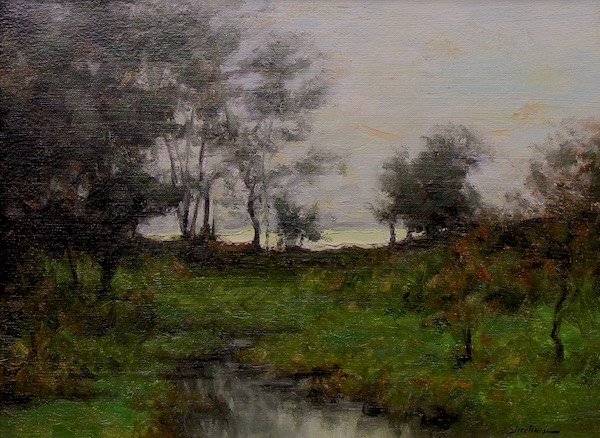
Dennis Sheehan (b. 1950)
Edge of the Forest
Oil 9" x 12"
$1500
Dennis Sheehan, born in Boston in 1950, is a member of the Guild of Boston Artists, and currently lives and works in the New Hampshire countryside. His work is in major public and private collections, including the White House. Sheehan paints in the Barbizon mode with remarkable authority and faithful adherence to his 19th century precursors. In the tradition of the Tonalist painters, Sheehan creates landscapes of mood, affected by nature's changing seasons. "My goal is to have the painting emanate light, rather than be just a surface that records the reflections of light. This is why the shadow areas are important, for it is from them that this emanation proceeds. The light areas are focal points of this effort, but the power comes from the shadows."
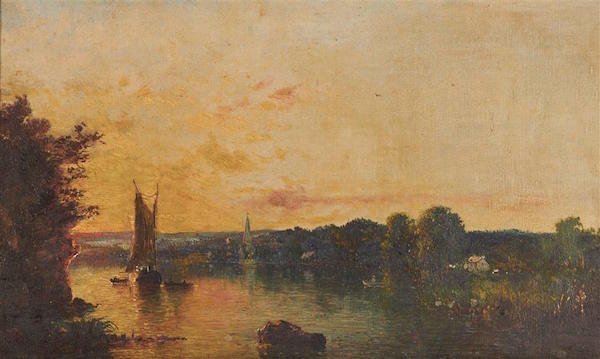
George Loring Brown (1814-1889)
Sun Set
Oil on canvas, 8 3/4 x 14 3/4, frame: 11 1/2 x 17
$3500
George Loring Brown was among the most celebrated of American painters of the 19th century. He began his artistic career as an apprentice to Abel Bowen and received further training from Eugene Isabey in Paris during his first trip to Europe in 1832 to 1833. On his return to Boston, Brown was inspired and encouraged by the aging Washington Allston, and exhibited frequently at the Boston Athenaeum. In 1839 he returned to Europe and settled in Italy, making a comfortable living for nearly twenty years by painting Italian landscapes to sell to both American and European tourists.
In 1859 Brown returned to the United States, and in the 1860s and 1870s he worked as an illustrator and painter, creating landscapes inspired by his surroundings in New England as well as his memories of Europe. (Landscapes of Europe and America 1834-1880, George Loring Brown, Robert Hull Fleming Museum, 1973).
Perhaps Brown’s greatest New Hampshire scene was The Crown of New England, a huge panoramic view of Mount Washington, which was purchased by the Prince of Wales in 1861. Brown exhibited at the Boston Athenaeum, the Brooklyn Art Association, the Pennsylvania Academy of Fine Arts, and the National Academy of Design.
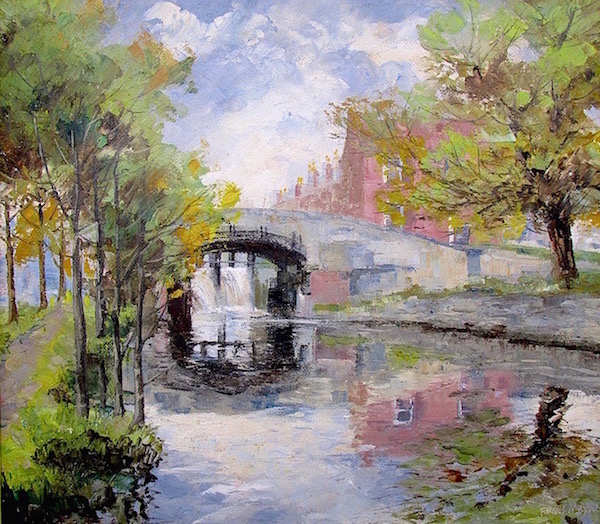
Fergus O'Ryan (b. 1911)
Leeson St. Bridge
Oil on board 19x 21/ Framed 24x 26
$2500
Born in 1911 in Limerick, Fergus O'Ryan was one of the major Irish artists of the 20th century. After studying at the Limerick School of Art he moved to Dublin where he attended the Dublin Metropolitan School of Art. In 1938 he first exhibited at the Royal Hibernian Academy and kept exhibiting there nearly every year until 1984, becaming a full RHA member in 1960. O'Ryan's work is firmly rooted in Ireland, depicting its wild landscapes as well as its busy urban scenes and industrial settings. His style varies from impressionistic strokes to highly-finished details. Particularly noteworthy is his ability to evoke the transparency and reflective qualities of water using it as a feature of the foreground.
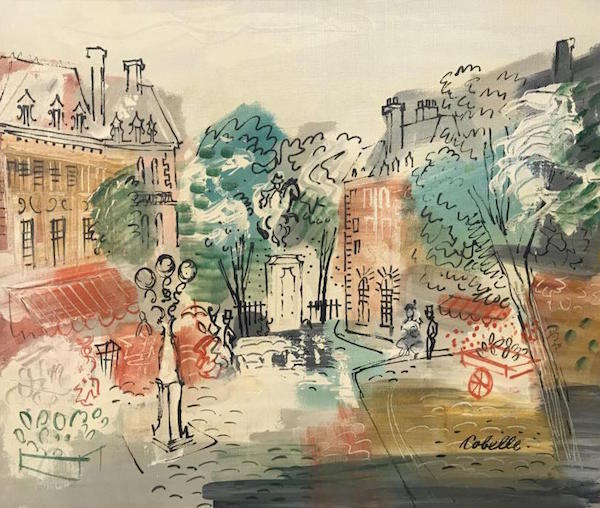
Charles Cobelle (1902- 1998)
Parisian street
Oil on canvas. 23.5" x 19.5 - frame 30.5" x 26
$1500
Charles Cobelle was a modern French master of painting, lithography and a fine muralist born in Alsace-Lorraine, France. He lived and painted in Paris until the late 1920s and established himself within the great tradition of the School of Paris. Best known for his use of open lines within washes of tones and colors, he forged a personal style directly influenced by the works of French Fauvist artist Raoul Dufy, with whom he apprenticed as a young man. He studied at the University of Munich and the École des Beaux-Arts in Paris, as well as with Marc Chagall, before emigrating to the United States in the late 1920s.
By the 1950s, spurred by the commercial success of his mentor, Raoul Dufy, Cobelle had achieved phenomenal success with his Parisian-influenced style. Throughout his long and prosperous career, Cobelle continued painting lively scenes of regattas, horse races, and French towns even after moving from France and settling in Connecticut, where he eventually gained American citizenship. His paintings are characterized by thin, descriptive line-work over broad patches of bold color. First, Cobelle would map out a scene in blocks of bold, expressive color. Then, he would define the imagery with spontaneous, fluid line work. This imagery, combined with a vibrant palette of expressive colors, creates a world full of verve and wit that effortlessly transcends reality.
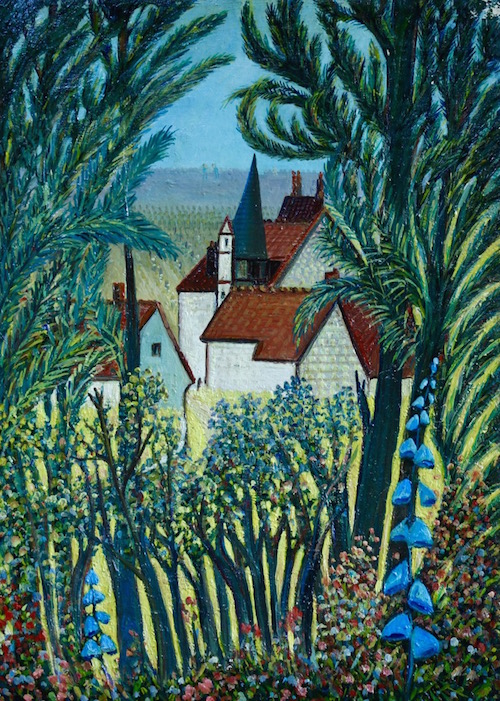
Ferdinand Desnos (1901-1958)
Flowers Before a Village
22 x 15 Oil on canvas
$1800
Ferdinand Desnos was a French naive painter in the tradition of Rousseau whose work is compared to his contemporary Camille Bombois. The artist work became critcially acclaimed in 1854 - sadly a bit late for the painter who died just a few years later. He painted nearly 800 canvases and took part in many group exhibitions, including: 1941, the first Salon de la Paysannerie Française, Paris; 1945, Salon d'Hiver, Paris; 1945, Salon des Vrais Indépendants, Paris; From Vallotton to Desnos ( De Vallotton à Desnos), Vevey Museum; 1968, 20th-century Primitives ( Primitifs du XXe siècle), Le Creusot; 1974, Five French Naive Painters ( Cinq peintres naïfs français), Maison de la Culture et des Loisirs; 1977, Naive Painters, National Museum of Modern Art, Tokyo; 1982, The Genius of the Naive Painters ( Le Génie des naïfs), Salon des Indépendants, Paris; 1990, The Douanier Rousseau and the 20th-century Primitives ( Le Douanier Rousseau et les Primitifs du XXe siècle), Musée du Petit Palais, Geneva; 1992, Henri Rousseau and Naive Art ( Henri Rousseau et l'Art naïf), Chiba, Japan, travelling exhibition.
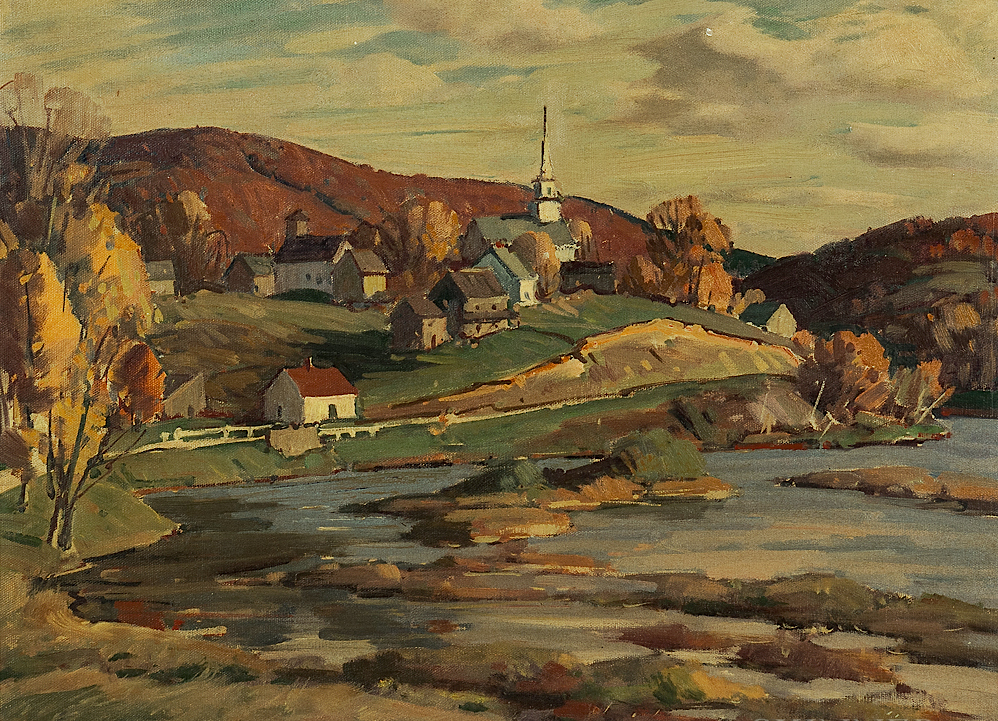
Aldro Hibbard N.A. (1886-1972)
South Londonderry, Vermont
Oil on canvas, 17 x 21, Framed 23 x 27
$6500
Born in Falmouth, MA in 1886, Aldro Thompson Hibbard received his early art training at the Boston Museum School where he studied with Edmund Tarbell, Frank W. Benson and Joseph DeCamp. Due to his exceptional talents, Hibbard received a Paige Traveling Scholarship (1913-15) to study abroad. Hibbard later founded the Rockport Art Association Summer School of Drawing and Painting (1921-28), also known as the Hibbard School of Painting. The Rockport Art Association recently held a special retrospective exhibition for him.
Beginning in the 1920s, Hibbard resided in the Cape Ann, Massachusetts area and spent his winters in Vermont and Jamaica. Vermont was the locale of many impressionistic winter landscapes for which Hibbard is best known. In fact, he was so adept at painting snow scenes, a review in the Boston Globe for the 1918 Guild of Boston Artists exhibition noted: “Hibbard is a realist; you feel the reality of everything he paints, but the sentiment, the poetry is there also.” (1)
Source: (1) Cooley, John L. A.T. Hibbard, N.A.: Artist in Two Worlds. Concord: The Rumford Press, 1968; p. 55.
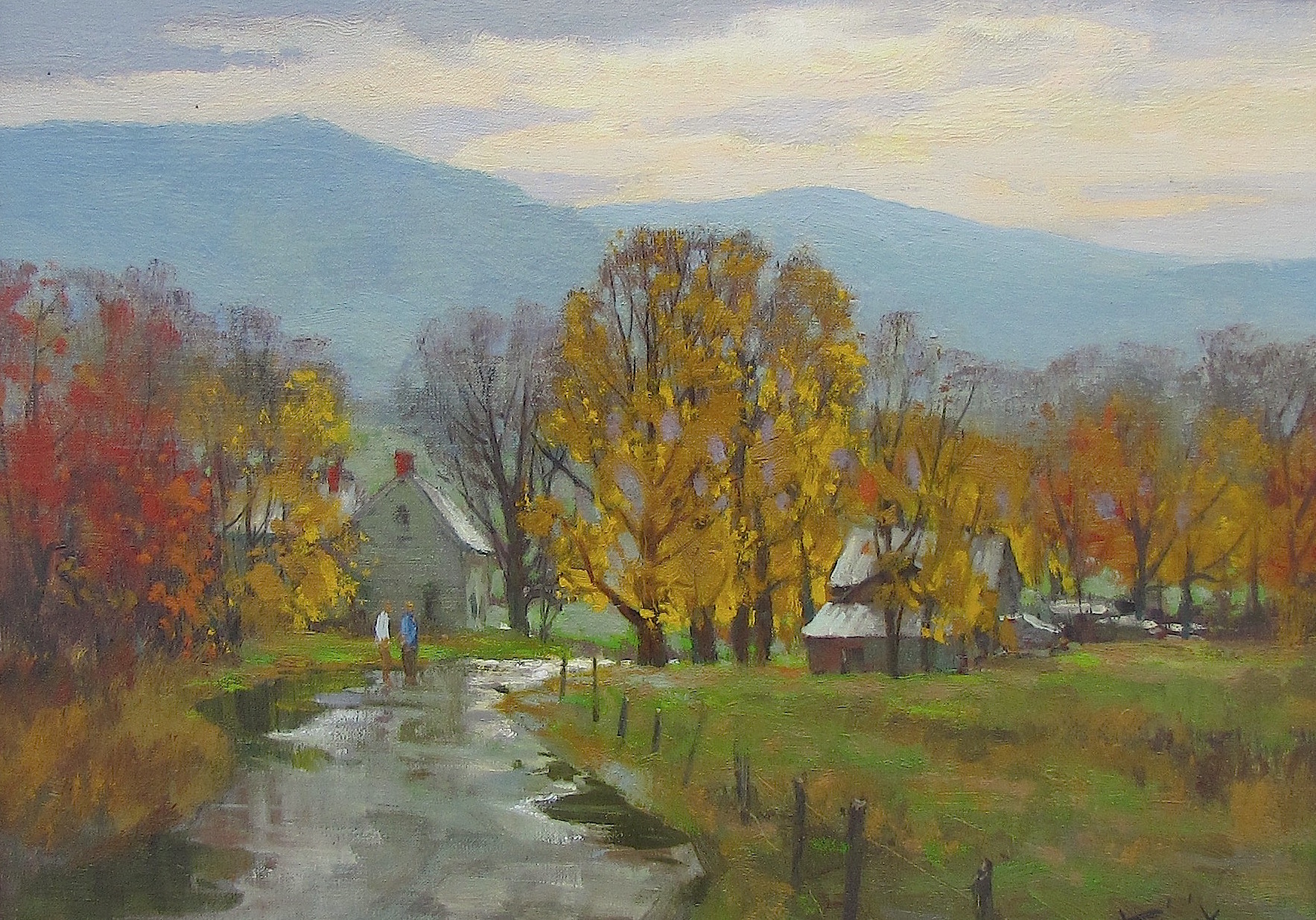
Paul Strisik N.A. (1918-1998)
Clearing
10 x 14 Oil on linen
Housed in a modern gilt frame with linen and gilt liner 18.5 x 22.5
$3000
Born in Brooklyn, New York, Paul Strisik became a resident of Rockport, Massachusetts, where he did landscape painting that brought him national recognition. After serving in the Navy during World War II, he studied at the Art Students League in New York City and with Frank Vincent DuMond. In 1953, he moved to Rockport, where he was active in the Art Association and other local civic organizations.
He was a member of the National Academy of Western Art, the American Watercolor Society, and the Oil Painters of America. During his long career, he won 185 awards including 16 gold medals. He and his wife, Nancy, also maintained a home in Santa Fe for 12 years, and in 1996, he was honored as Artist of the Year by the Santa Fe Rotary Club. He was widely respected for his willingness to share his talents with young artists, and taught numerous workshops including at the Scottsdale Artists' School. He wrote several books, his last one being "Capturing the Light in Oils." A reviewer in "Art Talk" quoted him: "God's light on a blade of grass is such a miracle, and so difficult to capture in paint; it is worth a lifetime of trying" (10/98). He died July 22, 1998 at his home in Rockport.
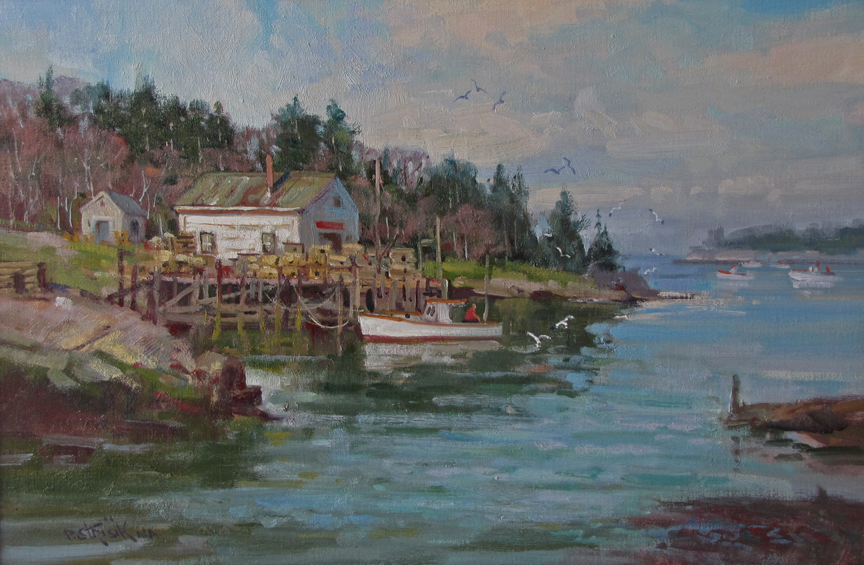
Paul Strisik N.A. (1918-1998)
Morgan’s Cove
Oil on canvas 16 x 24
giltwood frame with linen liner 24 x 32
$6500
Born in Brooklyn, New York, Paul Strisik became a resident of Rockport, Massachusetts, where he did landscape painting that brought him national recognition. After serving in the Navy during World War II, he studied at the Art Students League in New York City and with Frank Vincent DuMond. In 1953, he moved to Rockport, where he was active in the Art Association and other local civic organizations.
He was a member of the National Academy of Western Art, the American Watercolor Society, and the Oil Painters of America. During his long career, he won 185 awards including 16 gold medals. He and his wife, Nancy, also maintained a home in Santa Fe for 12 years, and in 1996, he was honored as Artist of the Year by the Santa Fe Rotary Club. He was widely respected for his willingness to share his talents with young artists, and taught numerous workshops including at the Scottsdale Artists' School. He wrote several books, his last one being "Capturing the Light in Oils." A reviewer in "Art Talk" quoted him: "God's light on a blade of grass is such a miracle, and so difficult to capture in paint; it is worth a lifetime of trying" (10/98). He died July 22, 1998 at his home in Rockport.
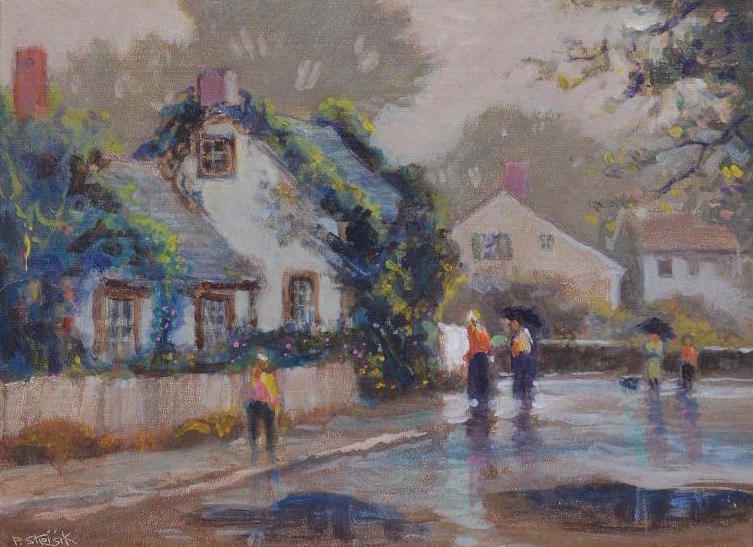
Paul Strisik N.A. (1918-1998)
Rockport Village
Oil on board, 12 x 16
$2500
Born in Brooklyn, New York, Paul Strisik became a resident of Rockport, Massachusetts, where he did landscape painting that brought him national recognition. After serving in the Navy during World War II, he studied at the Art Students League in New York City and with Frank Vincent DuMond. In 1953, he moved to Rockport, where he was active in the Art Association and other local civic organizations.
He was a member of the National Academy of Western Art, the American Watercolor Society, and the Oil Painters of America. During his long career, he won 185 awards including 16 gold medals. He and his wife, Nancy, also maintained a home in Santa Fe for 12 years, and in 1996, he was honored as Artist of the Year by the Santa Fe Rotary Club. He was widely respected for his willingness to share his talents with young artists, and taught numerous workshops including at the Scottsdale Artists' School. He wrote several books, his last one being "Capturing the Light in Oils." A reviewer in "Art Talk" quoted him: "God's light on a blade of grass is such a miracle, and so difficult to capture in paint; it is worth a lifetime of trying" (10/98). He died July 22, 1998 at his home in Rockport.
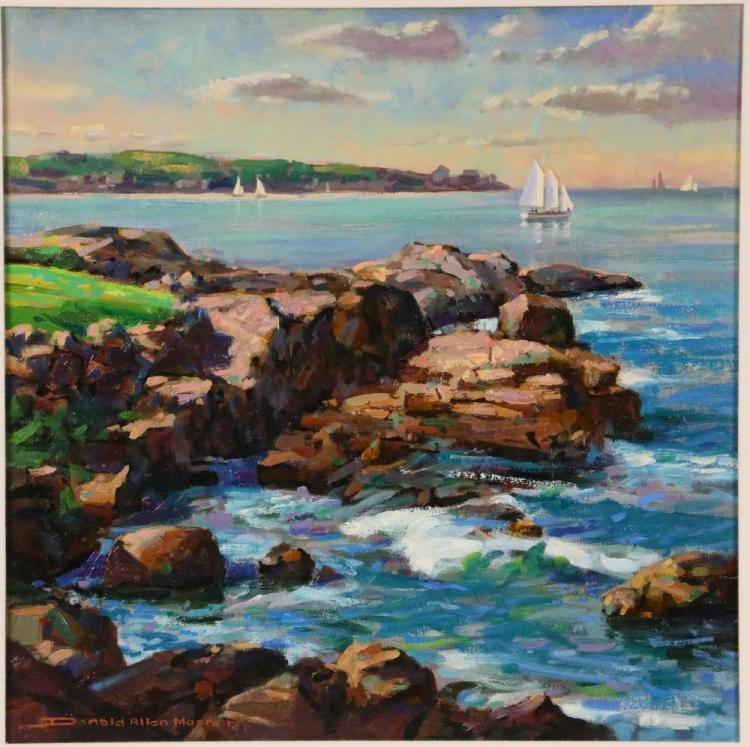
Donald Allen Mosher
Sunset Sail
Oil on Linen 18x18, Framed 26x26
$4500
Donald Mosher grew up on the North Shore and lived in Rockport since 1980 until his death in 2014. A descendant of ship builders from Nova Scotia and farmers from Maine, Don was naturally drawn to the power of the sea and the tranquility of the New England countryside. His interest in art began after winning his first award at the age of eight, and he has since won over 200 awards for his work. A 1968 graduate of Vesper George School of Art, Don was a painting instructor and has been featured in several national publications including American Artist. His paintings hang in the permanent collections of large corporations, institutions, banks, and private homes throughout the United States and abroad including the Peabody Museum, Portland Art Museum, and the State House in Boston.
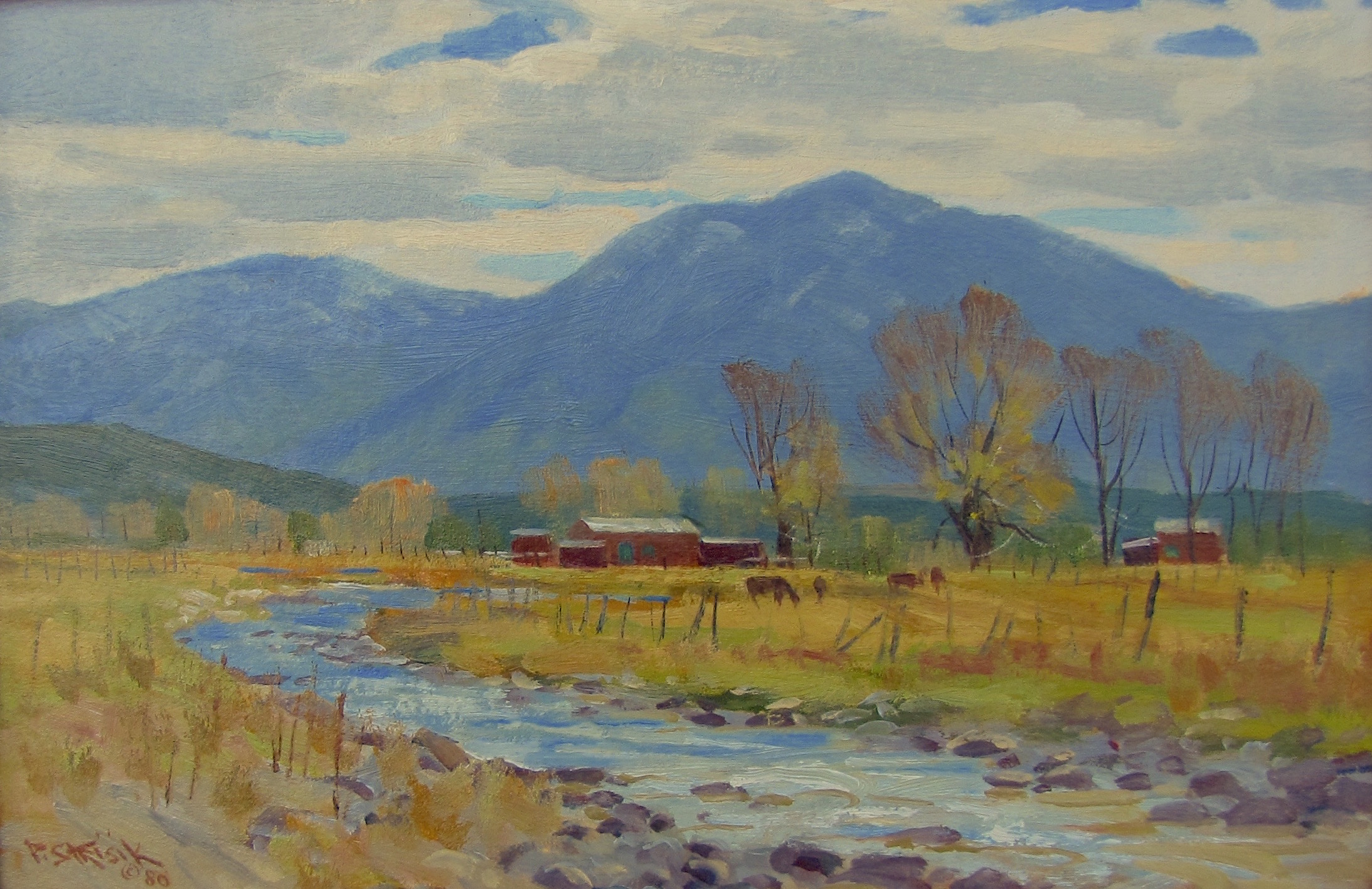
Paul Strisik N.A. (1918-1998)
Silvery Light, Arroyo Hondo
8 x 12 Oil
$2000
Born in Brooklyn, New York, Paul Strisik became a resident of Rockport, Massachusetts, where he did landscape painting that brought him national recognition. After serving in the Navy during World War II, he studied at the Art Students League in New York City and with Frank Vincent DuMond. In 1953, he moved to Rockport, where he was active in the Art Association and other local civic organizations.
He was a member of the National Academy of Western Art, the American Watercolor Society, and the Oil Painters of America. During his long career, he won 185 awards including 16 gold medals. He and his wife, Nancy, also maintained a home in Santa Fe for 12 years, and in 1996, he was honored as Artist of the Year by the Santa Fe Rotary Club. He was widely respected for his willingness to share his talents with young artists, and taught numerous workshops including at the Scottsdale Artists' School. He wrote several books, his last one being "Capturing the Light in Oils." A reviewer in "Art Talk" quoted him: "God's light on a blade of grass is such a miracle, and so difficult to capture in paint; it is worth a lifetime of trying" (10/98). He died July 22, 1998 at his home in Rockport.
|
See the calendar for future exhibitions.
|

|
|

